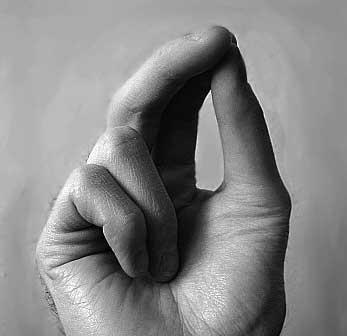From the earliest days of the church, Christians made the sign of the cross, but some reformers condemned it as a form of idolatry.

October 31, 2017 marks the 500th anniversary of the Protestant Reformation, an important date in the history of the United Church and for Reformed Churches around the world. To commemorate the occasion, we are publishing a series of blog posts by Trisha Elliott on "What Makes Us Protestant." Take a look at all the blog posts in this series.
In junior kindergarten, I went to the Roman Catholic school located conveniently across the road. There, I was taught to make the sign of the cross: forehead to chest, left shoulder to right shoulder. One of my earliest memories is pausing at a pew in my United Church when I was about four years old, making the sign of the cross, and my mother quietly hissing, “No. No. We don’t do that here. I’ll explain later.”
I don’t remember the explanation.
I doubt my mother would have harkened back to the Reformation’s “Bible tells me so” idea that the activity of the church and churchgoers ought to be kept or rejected based on its biblical merit. While the Book of Revelation describes the “seal of God on the head” in a handful of verses, the passages are more descriptive than prescriptive.
Biblical or not, the practice of making the sign of the cross enjoys a long history. As far back as 200 AD, Tertullian, an early church leader, described it as a tradition that marks the passages of daily life: “At every forward step and movement, at every going in and out, when we put on our clothes and shoes, when we bathe, when we sit at table, when we light the lamps, on couch, on seat, in all the ordinary actions of daily life, we trace upon the forehead the sign.”
From the earliest days of the church, practising Christians put their unique spin on the gestures. Even today, the way some Christians choose to hold their fingers while making the sign of the cross is theological. For example, Eastern Orthodox Christians sign themselves in the reverse direction (right to left) and press their thumb and two fingers together; the three digits joined as one represent the Trinity.
Most of the reformers left it up to individual Christians to decide whether signing was an appropriate expression of faith, but there were some who condemned it as a form of idolatry. Gradually, it fell out of favour with the majority of Protestants.
But as far back as kindergarten, I’ve liked it. Using not just our words but also our whole bodies has always appealed, and I’ve secretly longed for and dabbled in embodied, ritualized prayer whether it’s the Roman Catholic tradition of signing or the Muslim practice of prostration. Although I’m as wary as the reformers were of actions that can become superstitious, when it comes to the more sensory aspects of spiritual practice, I think we’ve thrown the baby out with the bathwater.
What do you think?
1. Is the rising popularity of yoga practices and pilgrimages evidence of a longing to blend body, mind, and spirit in spiritual practice? Why or why not?
2. How comfortable are you with embodied spiritual practices? What do you think lends to your comfort/discomfort?
3. What rituals (if any) are an important part of your faith life, and why?
—Rev. Trisha Elliott, Southminster Pastoral Charge, Ottawa
For worship materials for Reformation Sunday—including a bulletin insert for the 500th anniversary of the Protestant Reformation on October 31, 2017—see the Worship section.